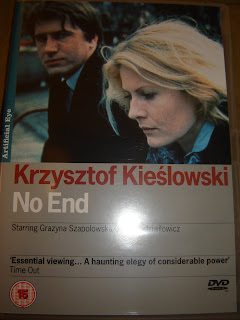 Since having my son I’ve sadly had less time to enjoy Polish film, but a couple of years ago I was a real addict. When I was studying Polish at the University of Glasgow I used to borrow Polish films from the language library on a weekly basis. A lovely Polish dad I met a few weeks ago reminded me how great Polish cinema can be, so I thought I’d take this opportunity to share with you a few of my Polish film favourites.
Since having my son I’ve sadly had less time to enjoy Polish film, but a couple of years ago I was a real addict. When I was studying Polish at the University of Glasgow I used to borrow Polish films from the language library on a weekly basis. A lovely Polish dad I met a few weeks ago reminded me how great Polish cinema can be, so I thought I’d take this opportunity to share with you a few of my Polish film favourites. Enjoy a Krzysztof Kieślowski month by working your way through his amazing repertoire of film; most notably, No End (Bez końca, 1984), The Decalogue (Dekalog, 1988), The Double Life of Véronique (La Double vie de Véronique / Podwójne życie Weroniki, 1991) and The Three Colours Trilogy which includes, Three Colours: Blue (Trois couleurs: Bleu / Trzy kolory: Niebieski, 1993), Three Colours: White (Trois couleurs: Blanc / Trzy kolory: Biały, 1994), and Three Colours: Red (Trois couleurs: Rouge / Trzy kolory: Czerwony,1994).
The Double Life of Véronique is my favourite Kieślowski film. It follows the life of Weronika, a young woman living in Poland against the parallel life of her doppelganger Véronique, who lives in France. Both parts are played by the superb actress Irène Jacob. The film has often been translated as a metaphor for the experiences of Poland during World War II compared to that of France. This is not a great film for anyone with an aversion to fantasy, but the original film score by Zbigniew Preisner resonates through the piece masterfully.
If seriously challenging historical or political film is more your style try the film of Andrzej Wajda. Examining the lives of communist workers and the Solidarity labour union movement are the films Man of Marble (Człowiek z marmuru, 1977) and Man of Iron (Człowiek z żelaza,1981). My favourite Wajda film is his 2007 film Katyń which details the wartime atrocity of The Katyń Massacre (zbrodnia katyńska - the 'Katyń crime'), whereby Polish prisoners of war (both officers and citizens) were ordered to be executed by the Soviet authorities in 1940. The film uses documentary footage from the period and exerts of newspaper articles to highlight the propaganda prevalent in the Soviet and German press at the time.
I also like Roman Polański’s first feature-length film Knife in the Water (Nóż w wodzie, 1962) which was his first major commercial success in the West. Despite being a very eerie thriller it still makes me want to visit the Mazury Lakes, Northern Poland. I enjoyed Sylwester Chęciński’s Our Folks (Sami Swoi, 1967) but my favourite Polish comedy is Killer (Kiler, 1996) by Juliusz Machulski. In terms of directing style I like the patience and attention to detail of Krzystof Krauze, particularly his film My Nikifor (Mój Nikifor, 2004).
In preparation for Agnieszka Holland’s visit to the University of Glasgow in 2007 I made my way through her entire film catalogue. Some of her films I found really sensitive and touching, A Woman Alone (Kobieta samotna, 1981) and an Angry Harvest (Bittere Ernte, 1985) for example, but some were not so gripping, The Healer (2004) for example. Nevertheless I was really inspired by Agnieszka Holland; she captivated her student audience when she told us about getting into the film industry. She spoke with great honesty and pride about her work. Although the temptation is to criticise Holland for moving away from her country and her independent filmmaking traditions, she has succeeded relatively well as a Hollywood blockbuster director, and this is great achievement in an industry ashamedly dominated by men, moreover, the very fact she took time to visit our Polish language class, shows she still holds her language and country true.
As for my favourite Polish film of all time, this, without a doubt is The Passenger (Pasażerka, 1963) directed by Andrzej Munk and Witold Lesiewicz. It was sadly to be Andrzej Munk’s last production as he died suddenly toward the end of filming. The narrative is patchy as a consequence, as sections were left unfinished to reflect the loss of the director. The film draws on the recollections of a German woman as she comes face to face with a woman she last met in Auschwitz. An amazing performance is given by actress Anna Ciepielewska and hence, według mnie, ten film trzeba zobaczyć!
For more resources on Polish cinema visit the archive at the film journal Kinoeye: http://www.kinoeye.org/archive/country_poland.php
For a general overview on Polish film follow this link:
To purchase any of the films mentioned in this blog try the website http://www.merlin.pl/ (it's the Polish version of Amazon).
**Lastly, I’ve found a North East England connection to Polish cinema! Cul-de-sac, the 1966 thriller directed by Roman Polanski was shot on location in Northumberland, on Lindisfarne (the Holy Island). The National Trust runs tours of the very castle featured in the film.











Cześć Rachel!
ReplyDeleteCo słychać? Ja bym czekał na ciebie jeszcze dwa dni lub trzy ... (I would have waited for you two more days or three ...)
Please visit and feel free to leave your web details in my Guestbook. Now a riddle for you (since you've seen the film): What is the hotel room number which is identical for both Antek in Krakow and Veronique in Paris?
Dobry wieczór,
Alexandre FABBRI